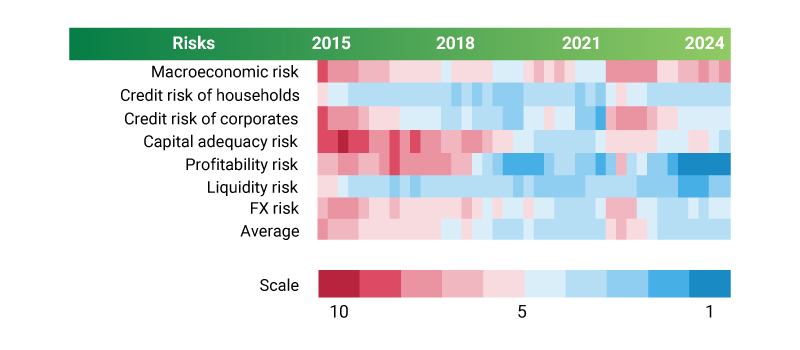Throughout 2024, the banks were able to provide uninterrupted services to businesses and households and channel more and more resources to the economy to overcome the fallout of the war. The liquidity, solvency, and operational resilience of the banking system do not raise any concerns. This is according to the Financial Stability Report.

Macroeconomic conditions are favorable for financial institutions
Economic growth continues despite russia’s energy terror. Steady inflows of international aid make it possible to finance the significant war-induced budget deficit, replenish international reserves, and to smooth out the structural war-related vulnerabilities of the Ukrainian economy. This enables the NBU to ensure the stable functioning of the FX market and smooth out excessive exchange rate fluctuations.
Inflation has accelerated now, but inflationary pressures will ease in the middle of next year after the new harvest arrives on the market. The NBU’s tightening of monetary conditions will halt the decline in commercial bank rates, which has been going on for more than a year.
The war remains the key risk to financial stability. While not posing immediate challenges to banks and non-bank financial institutions, it significantly increases their operating costs and restrains their risk appetites for developing certain business lines.
The banks’ liquidity is quite sufficient for further investment and lending growth
After a short period of seasonal volatility, corporate and retail deposits at the banks returned to growth. This growth supports ample liquidity in the banking sector – the banks are meeting short-term and long-term liquidity ratios with a margin.
The NBU’s tightening of reserve requirements and the banks’ more active investment in domestic government debt securities, while reducing the share of certificates of deposit in their high-quality liquid assets, will require the banks to manage their liquidity more actively. Therefore, one can expect more appealing terms for attracting client funds.
Lending continues to be brisk across all segments as demand strengthens
The net hryvnia corporate loan portfolio increased by more than 20% over the year (as of November 2024, since November 2023), while the retail loan portfolio grew by over 30%. In the latest lending survey, the banks reported an increase in demand for loans from clients (for corporate loans, the estimates are the highest since 2021).
The corporate loan portfolio is growing at banks of all groups and for companies of various sizes. Financial institutions are actively lending to agricultural, trading and industrial companies, contributing to their growth.
The step-by-step implementation of the Lending Development Strategy is eliminating existing gaps in the market, improving access to credit. A memorandum signed by the banks in the summer facilitated the financing of energy sector recovery on favorable terms.
In the retail unsecured lending segment, competition is even stronger than in the corporate lending sector. Despite the growth in loans, their penetration rate remains quite low relative to GDP and household incomes. Therefore, there is significant room for portfolio growth.
The role of state support in corporate lending is further weakening. Looking ahead, the design of state support programs should ensure the dominance of market mechanisms. At the same time, the role of government and international financial institution guarantees in covering credit risk is growing.
Continued rate declines prompted the banks to manage their assets more actively
The banks were largely able to maintain their returns on assets, so net interest margins remained high and profitability significant, allowing them to maintain high capital levels.
Another hike in the corporate income tax rate, to 50% was a major factor for the banks’ profitability. The practice of retrospective tax impositions greatly complicates capital planning for the banks and, for some, narrows lending opportunities.
The banks have successfully transitioned to a new three-tier regulatory capital structure, started setting aside capital to cover all of the key risks (credit, market, and operational ones), and have completed their first ICAAP capital adequacy assessment. Together, this has resulted in significant progress in harmonizing domestic banking regulations with EU standards. This work will continue.
Non-banks continue to transform under the influence of updated regulatory requirements
Market players are continuing to adapt to new legislation and to prudential requirements. The decline in the number of market participants did not narrow access to financial services. At the same time, the assets of the nonbank financial sector are growing, as is its resilience to adverse events. This will further promote the development of the non-bank financial services market, and boost confidence in it.









